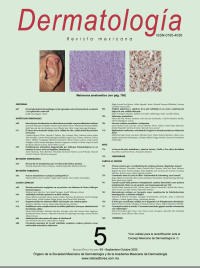Dermatol Rev Mex. 2025; 69 (5): 710-715. https://doi.org/10.24245/dermatolrevmex.v69i5.10746
Katherine López Soto,1 Luis Javier Méndez Tovar,1 Erika Córdova Martínez,1 Diana Guadalupe Santamaría Domínguez,2 Christian Didier Ortega Arévalo,1 Francisca Hernández Hernández1
1 Departamento de Microbiología y Parasitología, Facultad de Medicina, Universidad Nacional Autónoma de México.
2 Servicio de Dermatología, Hospital General Dr. Manuel Gea González, Secretaría de Salud, Ciudad de México.
Resumen
ANTECEDENTES: La papilomatosis confluente y reticulada de Gougerot-Carteaud es una dermatosis poco frecuente y benigna que afecta, principalmente, a mujeres jóvenes. En términos clínicos, se manifiesta por máculas y pápulas color marrón que forman placas de aspecto aterciopelado y patrón reticulado en el tronco superior, las axilas y el cuello. Anteriormente se consideraba una variante de la acantosis nigricans; sin embargo, actualmente se considera un padecimiento independiente.
CASO CLÍNICO: Paciente femenina de 14 años, referida a la Unidad de Micología por padecer una dermatosis de cuatro meses de evolución, diseminada en la región intermamaria y la cara posterior del cuello, caracterizada por máculas y pápulas hipercrómicas, bien delimitadas, algunas confluentes y asintomáticas, compatibles con el diagnóstico de papilomatosis confluente y reticulada de Gougerot-Carteaud. Los estudios micológicos y moleculares posteriores a la toma de escamas de la lesión permitieron establecer a Malassezia furfur como el agente asociado.
CONCLUSIONES: La papilomatosis confluente y reticulada de Gougerot-Carteaud es una dermatosis que tiende a mostrar una respuesta favorable parcial al tratamiento antifúngico cuando no se asocia con Malassezia furfur. La mejoría adicional con la administración de corticosteroides sugiere un componente inflamatorio y un trastorno de la queratinización, lo que abre la posibilidad de combinar estos agentes en el tratamiento para lograr el alivio clínico.
PALABRAS CLAVE: Papilomatosis; Malassezia; acantosis nigricans.
Abstract
BACKGROUND: Confluent and reticulated papillomatosis of Gougerot-Carteaud is an uncommon and non-serious dermatosis affecting mainly young women. Clinically, the disease is manifested as brown macules and papules that form velvety plaques with a reticulated pattern, primarily on the upper trunk, armpits, and neck. Previously considered a variant of acanthosis nigricans, this disease is now recognized as an independent clinical entity.
CLINICAL CASE: A 14-year-old female patient referred to the Mycology Unit for evaluation of a 4-month history of dermatosis localized at the intermammary region and the back of the neck. The lesions were characterized by hyperpigmented, well-demarcated macules and papules, some of them confluent and asymptomatic, consistent with a diagnosis of confluent and reticulated papillomatosis of Gougerot-Carteaud. Mycological and molecular studies performed on scales obtained from the lesions identified Malassezia furfur as the associated agent.
CONCLUSIONS: Confluent reticulated papillomatosis of Gougerot-Carteaud is a dermatosis that responds favorably to antifungal treatment and is not associated with Malassezia furfur. The primary treatment with corticosteroids suggests an inflammatory component and a keratinization disorder, raising the possibility of combining these agents in treatment to achieve clinical relief.
KEYWORDS: Papillomatosis; Malassezia; Acanthosis nigricans.
ORCID
https://orcid.org/0009-0000-0647-9444
https://orcid.org/0000-0003-3859-8688
https://orcid.org/0009-0000-3896-4460
https://orcid.org/0009-0009-0331-3727
https://orcid.org/0009-0000-3767-1818
https://orcid.org/0000-0002-3473-362X
Recibido: abril 2025
Aceptado: mayo 2025
Este artículo debe citarse como: López-Soto K, Méndez-Tovar LJ, Córdova-Martínez E, Santamaría-Domínguez DG, Ortega-Arévalo CD, Hernández-Hernández F. Papilomatosis confluente y reticulada de Gougerot-Carteaud asociada con Malassezia furfur. Dermatol Rev Mex 2025; 69 (5): 710-715.

